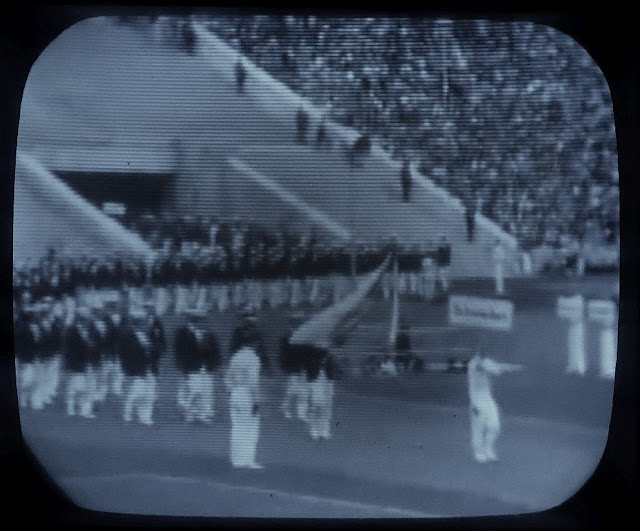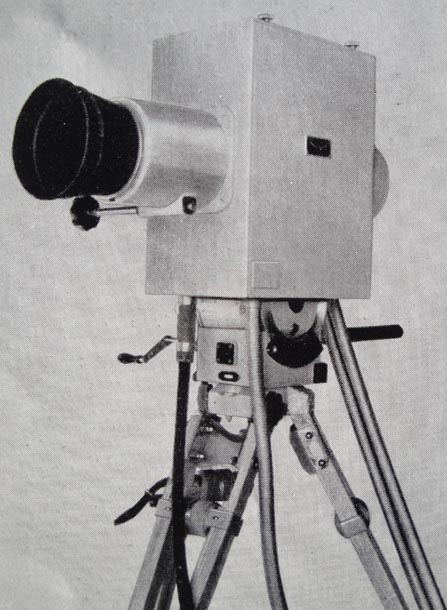Given that the UK high definition television service did not officially start broadcasting until the 2nd of November 1936 it could be claimed that Germany were the first in the world to launch a regular public service. It really all depends on how you define high definition.
At the time of the Olympics there were no television receivers on sale to the general public in Germany. Prior to the Olympic games the public could view television at seven public viewing rooms in Berlin and one in Potsdam. These were typically equipped with a number of domestic sized receivers with screen size 19 x 22 cm using a 180 line non-interlaced 25 Hz frame rate. The viewing rooms could seat between 30 and 40 people and the plan was for 25 such rooms and two theatres, one seating 100 and the other 300 people, to be available during the games and extending as far as Leipzig.
Two Telefunken cameras provided a total of 29 hours of broadcasting. These cameras were located for the full 16 days in two largely fixed positions on the south side of the Olympic Stadium at track level.
A further 180 line / 25Hz iconoscope camera constructed by the German Post Office provided a total of 24 hours of broadcasting. This was located in the Swimming Stadium for the full 16 days.
A CRT projection system to be used in the smaller theatre and an intermediate film projector in the larger. (Interestingly, although the IF projection had the brightness of cine presentation the results were described by Abramson at the Berlin Radio Exhibition in August 1933 as: "not very good, the image being 'thin' and marred by splashes and bubbles on the film." The process was expensive when new film was used so a continuous loop was tried in which the film was stripped after presentation and the emulsion renewed. ) I've not seen it referred to but I would assume that the IF projection would have the advantage of being flicker free as it was projecting frame by frame just as in a normal film projector.
So how did the German system compare with the Marconi EMI system that was available to the public in August 1936 in the UK ?
A 180 line image of Test Card C:
The Telefunken receivers had an IF response giving 850 kHz video bandwidth which equates to a resolution similar to the middle of the 5 grating set in Test Card C.
Clearly the line structure of a 180 line picture is going to be more prominent than that of a 405 line picture. (Running a 405 line set at 180 /25 Hz doesn't improve the linearity in either axis but it's not quite so obvious in the four 180 line screen shots from the Olympics below.)
A 405 line image of Test Card C:
Given the screen dimensions used in the German viewing rooms the difference in line count was probably not a big issue but the 25 Hz non-interlaced scanning would have given the same rather objectionable flicker that plagued the Baird system offering at that time. The video below gives a comparison of the 405 line system against the Baird 240 line system. The German 180 line system had the same level of flicker as in the Baird system.
It is likely that the Nazi regime opted to go public with the 180 line system to be seen as world leaders in television but like others they were limited by camera technology.
Three types of television camera were used at the Olympic Stadium. Those manufactured by Telefunken used RCA iconoscope technology purchased under licence. Contrary to what is implied elsewhere on the web the iconoscopes used in these cameras were not the miniature super iconoscopes that were manufactured towards the end of WWII for use in television guided weapons. The Telefunken cameras in 1936 used the 180 line / 25 Hz format and a standard iconoscope of very similar construction to the then current RCA design and had a mosaic target 9 x 12 cm . Three different fixed lenses were used, a 25 cm and 90 cm from Carl Zeiss and a 160 cm Leitz lens. (For those more familiar with 35 mm lens the sizes these equate to 75 mm, 270 mm and 480 mm.) The 160 cm lens (immediately below) had a 40 cm objective lens and weighed 45 kg. When fitted with this large telephoto lens the camera body was slid backwards on the cradle to give a better weight balance. A mirror system gave the camera operator a direct optical viewfinder image of the iconoscope mosaic. Apparently it was Emil Mechau, better known for his telecine machines, who designed the Olympic camera when working for Telefunken.
These cameras could have been capable of operating at the 441 line standard that was adopted a year or so later but they were supplying images for reception in the viewing rooms that were equipped with 180 line receivers, a standard compatible with the "purely German" technology of the Fernseh intermediate film camera, as shown below mounted on its film processing/scanning van that was also used at the Olympic Stadium. The third camera type was a much more portable device of the image dissector type also supplied by Fernseh AG but suffering from the light insensitivity and geometry problems common to this type.
Two Telefunken cameras provided a total of 29 hours of broadcasting. These cameras were located for the full 16 days in two largely fixed positions on the south side of the Olympic Stadium at track level.
A further 180 line / 25Hz iconoscope camera constructed by the German Post Office provided a total of 24 hours of broadcasting. This was located in the Swimming Stadium for the full 16 days.
The Fernseh AG intermediate film camera mounted on its processing van provided a total of 34 hours of broadcasting. It was located at the Marathon Gate between the Reich Sport Field and the May Field for the full 16 days. Fernseh AG had been formed in 1929 by the four equal partners, Bosch, Zeiss-Ikon, Loewe and Baird International Television. In 1933 Hitler required that Fernseh AG be a totally German company and the Baird company had to sell its share to the other partners but informal technical information continued to be shared on both the disc scanning systems and the Image dissector camera up to the outbreak of the war.
The Fernseh AG image dissector camera provided a total of 19 hours of broadcasting. It was located for 13 days in the Olympic Stadium and 3 days in the Dietrich Eckart Open Air Theatre.
Prior to the Olympics the Reich Broadcasting Company had delivered 2 hours of television per day between 8-00 pm and 10-00 pm. During the Olympics the broadcasting hours were extended to include transmissions between 10-00 am and 12-00 noon and between 3-00 pm and 7-00 pm. Some of this was live television coverage and some telecine from the film camera coverage.
Reporting in the Wireless World August 21st their correspondent was rather less than impressed with initial television coverage, the clarity being insufficient and the projection receivers being unreliable. The images from the iconoscope cameras were shadowy and distorted in the dull weather conditions. Those from the intermediate film camera were reported as quite clear and contrasty but accompanied by badly distorted sound, noting that its recording on the film suffered from the rapid development process.
As a response to the August report Manfred von Ardenne writing in the September 11th edition commented that "The quality of the "direct" television transmissions improved during the early stages of the Games almost from day to day, so that by about the middle of the Games, thanks to the accumulated experience in practical transmission technique, quite a useful picture quality was attained - not quite up to the standard of ordinary film transmissions but noticeably approaching this.
In order to have, in later days, an objective record of the results of the first official "direct" television transmissions using today's regulation 180 lines per picture, some characteristic fluorescent-screen images of the transmissions were photographed in the writer's laboratory. These are here reproduced without retouching."
The first image below was taken in cloudy weather with the iconoscope camera at the starting point in the swimming stadium just before the gun was fired, the others in the Olympic Stadium. Admittedly the images are probably not enhanced by the magazine reproduction.
Perhaps a fairer representation of the picture quality of the 180 line transmissions from the Berlin station is given in the von Ardenne book "Cathode-Ray Tubes". He shows three images taken from the screen of a receiver distant from the transmitter of a film that was transmitted in 1935. These are of course sourced from a film scanner rather than from a television camera.
https://tinyurl.com/3tknhc4f



















Комментариев нет:
Отправить комментарий